While walking across London’s Westminster Bridge, you’re unlikely to hear anyone ask for the time. After all, the iconic Big Ben, visible right next to you, surely tells the time with much greater precision than any passerby’s watch.
Big Ben is the clock tower of the Palace of Westminster and one of the most iconic symbols of London and the United Kingdom. I think everyone will agree that it’s also the world’s most famous clock. If you’re visiting the English capital, look for it at the northern end of the British Parliament building, right in the heart of London, next to the River Thames. Where did the name of the bell at the top of the tower come from? What secrets does Big Ben hold, and can you tour its interior? You’ll find the answers to these and many more questions in the article below.
Big Ben or Clock Tower?
Let’s start by uncovering the origin of the name for this famous clock tower. The name “Big Ben” originally referred specifically to the largest bell housed within the Clock Tower (also known as St. Stephen’s Tower). Over time, however, people began to use the popular nickname to refer to the entire tower, and today it’s commonly used to describe not only the bell and the building but also the clock itself.
As for the name of the bell itself, there are a few hypotheses. Most sources suggest that it was named after Sir Benjamin Hall, the chief commissioner overseeing the construction during the installation of the bell in 1858. This was meant as a tribute to the most important person involved in creating the iconic symbol of London. However, this is not the only theory. Some claim that the name honors a 19th-century heavyweight boxer, Benjamin Caunt, who was known by the nickname Big Ben.
DID YOU KNOW: Big Ben has had an additional name for several years. On September 12, 2012, marking Queen Elizabeth II’s 60th year on the throne, the tower was officially renamed Elizabeth Tower in her honor. Today, it is commonly referred to as Elizabeth Tower by the British royal family.
Why Was Big Ben Built?
During the Great Fire of 1834, the London Parliament building was almost completely destroyed. Only Westminster Hall and St. Stephen’s Chapel survived. To provide a new home for the chambers as quickly as possible, a public competition for the design of a new palace was immediately announced. The commission had no doubts and unanimously selected the proposal by Charles Barry. The architect had always envisioned a clock tower in his plans, though it initially had little to do with the beloved Big Ben we know today.
The grandeur and significance of this part of the palace are thanks to Augustus Welby Pugin, a young architect working alongside Barry. He provided the main architect with an impressive “detail” that drew attention to the massive new building. Sadly, Pugin never saw the tower completed. Before his death in 1852, he left a letter admitting that he had never worked with such passion as during the construction of what is now London’s iconic symbol.
The Most Accurate Clock in the World
Neither Barry nor Pugin were clock experts, so they sought help from specialists—Edmund Beckett Denison and George Airy, the royal astronomer. This exceptional timepiece had to be accurate to the second, with no margin for error. Designing such a mechanism was a major challenge, but they succeeded. After two years of development, the clock successfully passed rigorous tests comparing its accuracy to that of the Royal Observatory in Greenwich, where the country’s most precise chronometers were housed.
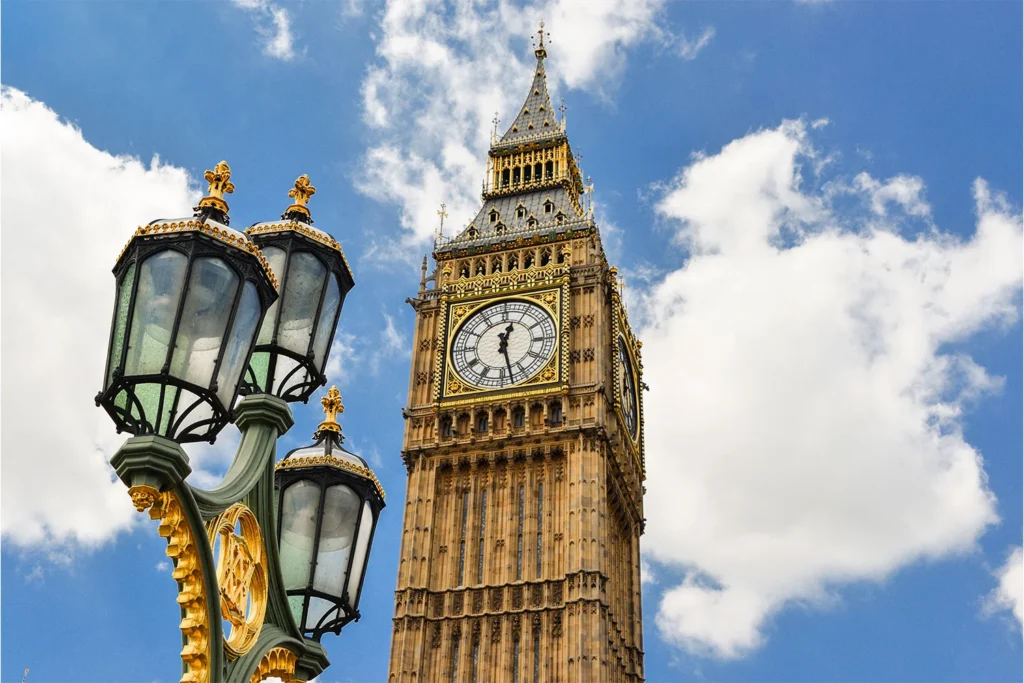
How Big Ben Was Created?
The casting of the gigantic bell presented significant challenges. The first bell was cast in 1856, but it failed the tests, so it was melted down and recast into a slightly lighter version. This second attempt seemed to meet expectations, and the bell was hoisted to the top of the tower and installed. Although the tower stood by the Thames as early as 1858, Big Ben was first activated on July 11, 1859.
However, Londoners didn’t enjoy the sound of Big Ben for long. By September 1859, the bell cracked, and Big Ben fell silent for four years. Sir George Airy came up with a solution. He ordered the bell to be rotated so that a new, lighter hammer would strike a different part of the bell. Additionally, a small square was cut into the metal to prevent the crack from spreading. The fix worked! The crack and cut-out square are still visible on Big Ben’s surface today, but they don’t interfere with the pleasant tones of the famous bell.
Elizabeth Tower in Detail
The tower, commonly known as Big Ben, stands 96 meters tall—equivalent to an 11-story building or, to help you visualize it, about 21 London buses stacked on top of each other. At the top are four clock faces, one on each side of the tower, each with a diameter of seven meters. While it’s hard to notice with the naked eye, each clock face is made up of 324 pieces of opal glass set in a steel frame. The hours are marked by Roman numerals that are 60 centimeters tall. Surrounding the clock faces is the Latin inscription “Domine salvam fac reginam nostram Victoriam primam,” which means “O Lord, keep safe our Queen Victoria I.”
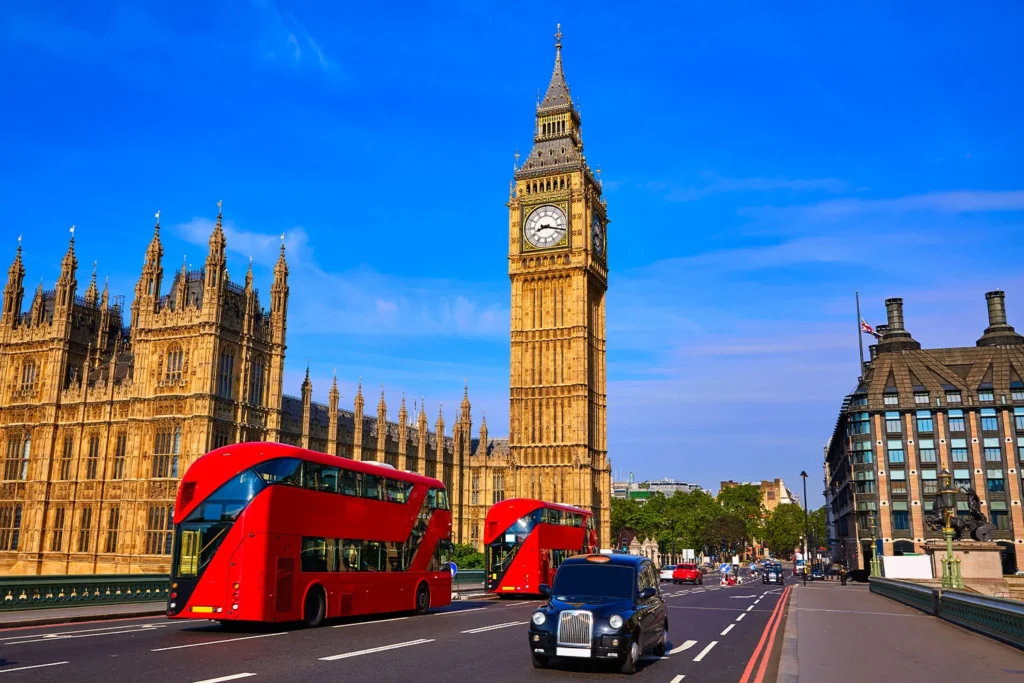
And What About the Famous Bells? The tower is home to not just the famous giant bell known as Big Ben, but also four smaller bells. These are significantly smaller than the iconic Big Ben, which weighs 13.7 tons. The second largest of the smaller bells weighs “only” 4 tons, while the remaining three each weigh just over 1 ton. Unlike most bells that swing back and forth, all the bells in the tower are fixed in place and struck by hammers from the outside.
DID YOU KNOW: The hour hands of the famous London timepiece are 2.7 meters long and weigh a hefty 300 kg each. The minute hands, however, are three times lighter, as they are made from copper sheet metal instead of solid metal. It has been calculated that the minute hands travel the equivalent of 190 kilometers in a year! That’s roughly the distance you’d cover traveling from Warsaw to Białystok.
English Punctuality
The accuracy of the clock is influenced by external factors such as wind or heavy rainfall, which are common in London. But regular delays on the world’s most famous clock simply couldn’t be allowed. This is why Edmund Beckett Denison designed a special mechanism to counteract these conditions and ensure Big Ben’s precision.
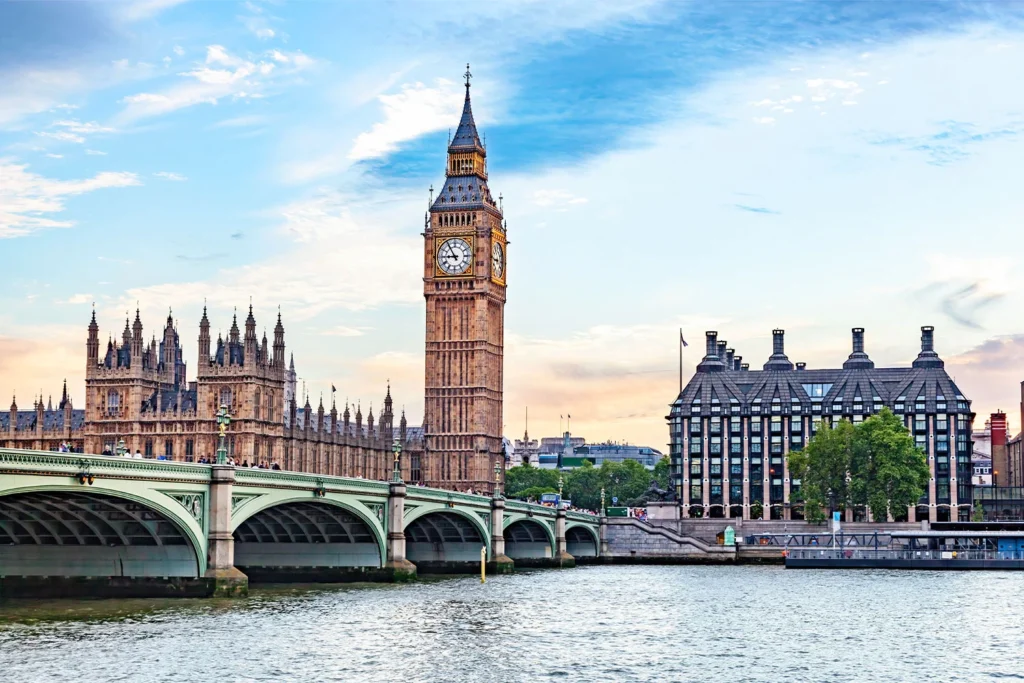
Although it is considered one of the most reliable clocks in the world, the symbol of London is not infallible. Take, for example, the year 1949, when a flock of starlings perched on the minute hand, causing Big Ben to be delayed by 41 minutes. The British likely will never forget New Year’s Eve in 1962, when due to heavy snowfall, the clock was delayed, and they rang in the New Year 10 minutes late.
There have also been complete halts in the clock’s operation. For the first time, the hands stopped in 1877 to allow for a three-week cleaning process of the mechanism. In 1976, the first major malfunction occurred, resulting in Big Ben being silent from August 10th until May 9th, 1977. In 2005, the clock experienced its longest maintenance break in 22 years, stopping for about 33 hours.
Big Ben – Curious facts and trivia
A Dial Full of Secrets
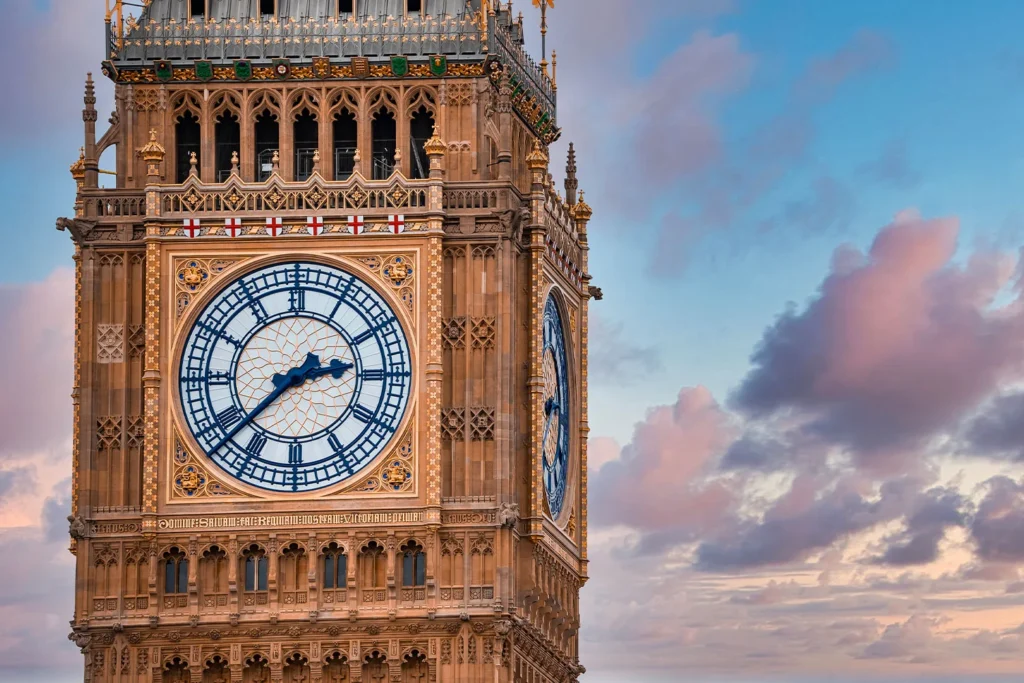
Not everyone knows that around each clock face on the tower, there are symbols significant to the United Kingdom. On the high pedestal, you can spot 52 emblems representing the national symbols of the four countries of the UK. You’ll find the English rose, the Scottish thistle, the Irish shamrock, and the Welsh leek. Upon closer inspection, you’ll also notice the pomegranate of Catherine of Aragon, the first wife of King Henry VIII of the Tudors, and the purslane flower, symbolizing both Houses of Parliament.
Clock Lights
At night, each of the four clock faces is illuminated from within. Originally, the faces of Big Ben were lit by gas lamps only during parliamentary sessions. Since 1876, the light has been lit daily, and in the early 20th century, the gas lamps were replaced by electric bulbs. The clock’s glow was extinguished only during World War II, out of fear that it might aid enemy bomber pilots in navigating.
3… 2… 1… Happy New Year!
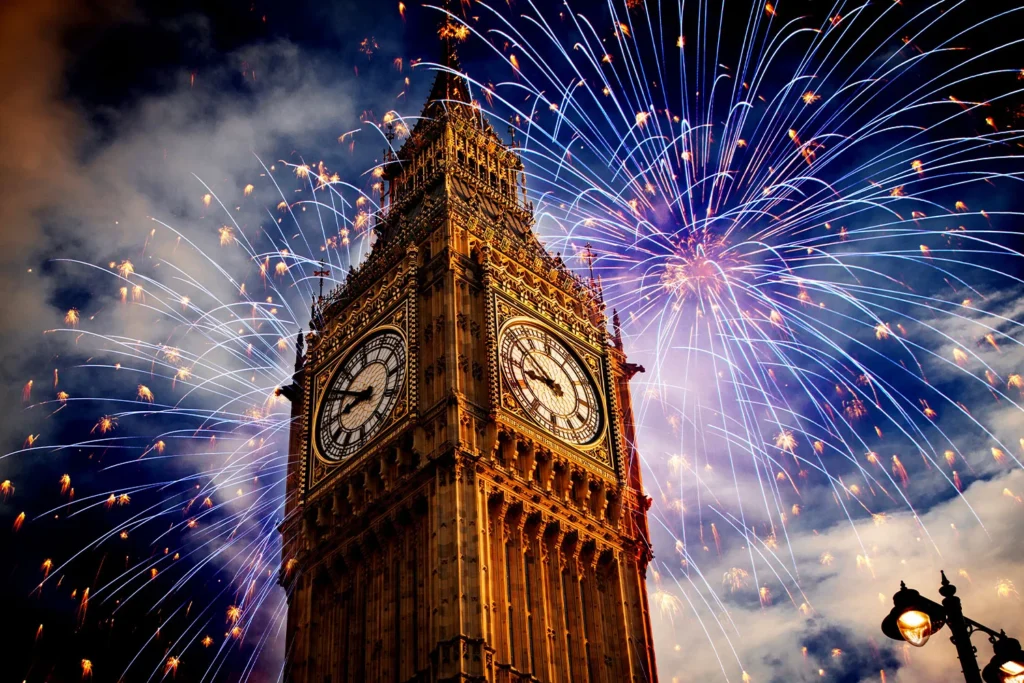
Big Ben is not just a popular London landmark. The building has also become an integral part of British culture. On New Year’s Eve in 1923, the BBC World Service broadcasted the sound of the bell live for the first time. Today, no English person can imagine bidding farewell to the old year without the accompaniment of Big Ben’s twelve strikes.
Ayrton Light
In 1873, at the initiative of Acton Smee Ayrton, the then Commissioner of Works, a lantern was installed above the bell tower. The Ayrton Light, as it’s called, still symbolizes when the House of Commons is in session after dark. Initially, the light was directed only towards Buckingham Palace, so that Queen Victoria could glance out of her window to see if a meeting was in progress.
The Great Renovation of the Great Tower
In August 2017, the largest renovation of Big Ben to date began. For five years, the project prevented disappointed tourists from seeing the famous clock tower. During the work, the clock faces were restored, energy-efficient LEDs were installed, and as many as 700 damaged stone elements were replaced. Fortunately, the renovation was completed in August 2022, so now nothing will stop you from taking the most Instagrammable photo in London.
A Close Encounter with Big Ben
While visiting the English capital, you certainly won’t miss the majestic Big Ben, even if you’re only spending a weekend in the city. However, if you’re planning to explore London in depth, you might be interested to know that the clock tower can be seen not just from the iconic outside view. What does it take to enter and discover the secret side of the world’s most famous clock? First of all, you need to be at least 11 years old and capable of climbing 334 steps. But that’s not the only requirement you’ll need to meet.
- First and foremost, you need to plan this attraction well in advance. Due to the limited number of people allowed up the tower each day, tickets sell out quickly.
- You can only enter the Big Ben tower with a guide, so don’t expect flexible hours, stops on the way up, or leisurely strolls at your own pace. You must enter at the designated time and descend with the group after the 90-minute tour.
- Inside the tower, consumption of food or drinks is prohibited, as well as taking photos or recording videos.
- It’s also worth knowing in advance that the tour involves high noise levels from the clock mechanism and bells. Before the tour, each participant receives earplugs, but for those particularly sensitive to sounds, the clamor may still be uncomfortable. This is also not a place for those with claustrophobia, as the staircase leading to the top is exceptionally narrow and steep.
What do you get for agreeing to all these conditions? A fairly long walk up the spiral staircase will lead you to the top of the belfry. During the tour, a specialist will tell you about the latest conservation project for the clock and the long history of the tower. You’ll be able to see the Big Ben mechanism from the inside, view the enormous clock faces up close, and even stand next to the world-famous bell. After your visit to the Elizabeth Tower, you can also explore the medieval Westminster Hall.
Practical information
- It is best to purchase tickets for the interior of Big Ben in advance. This way, you can avoid standing in long lines and reduce the risk of tickets being sold out.
- Address: London SW1A 0AA, United Kingdom
- Buy tickets on GetYourGuide